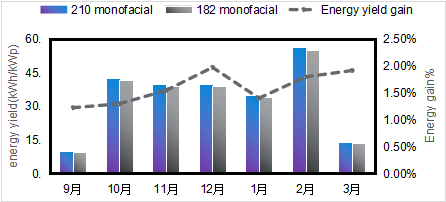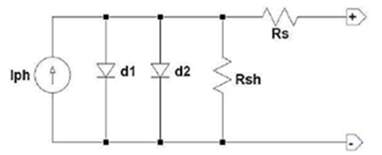Trina Solar, a leading global PV and smart energy total solution provider, has field test bases all over the world in full swing. Recently, Trina Solar unveiled the results of outdoor tests in two project locations, the national Photovoltaic Quality Inspection Center (CPVT) in Yinchuan, Ningxia Hui autonomous region, northwestern China, and the National Photovoltaic Science and Technology Laboratory (PVST) in Changzhou, Jiangsu province, showing that Trina Solar’s Vertex Module demonstrated significant advantages in field energy yield performance in a comparison with 182 modules. During the power generation test period, all 210 modules with obvious energy yield positive performance, the most of which is up to 1.6%. The advanced technology of Trina Solar's Vertex modules can reduce system costs in every way and becomes the new benchmark for high power modules of large ground power plants.
Yinchuan field test research:
210 module demonstrated higher energy yield compared with reference module, without risk to operating temperatures
The CPVT outdoor test site was in Yinchuan. This is the A level light irradiation area with a solar spectrum close to the standard AM 1.5. The annual radiation intensity is 500W/m2 and above for more than 2,000 hours. The average daily direct irradiation is 5.75 kWh/m2. Yinchuan has a temperate continental climate, with dry and hot summers and wide variances between morning and evening temperatures. The project began in April 2021 and is expected to be completed by April 2022.
Project Pictures and Module Installation Overview


Figure 1 Overview of Yinchuan project location
● Location: Yinchuan (38.47°N)
● Tilt angle: 40°
● Installation height: 1m
● Surface: sand
● Data collection method: High precision DC meter + inverter SG20RT-20
Data from April to September 2021 showed that the energy yield gain of the 210 mono-facial module was1.2% higher than that of the 182 mono-facial module.

Figure 2: A comparison of the energy yield of 210 and 182 monofacial modules
It is clear from the figure above that in the days with low energy yield, 210 modules show an obvious growth of energy gain. The comparison of different irradiation periods shows that 210 modules still have obvious advantages in low irradiation performance in the A Level light irradiation area.

Figure 3: A comparison of energy yield during different irradiation periods
Data from April to September 2021 shows, benefit from higher bifaciality, the energy yield gain of the 210 bifacial module being 1.3% higher than that of the 182 bifacial module.

Figure 4 A comparison of the energy gain of 210 and 182 bifacial modules
To calculate the operating temperature of the modules, four points were selected from each module, and the test equipment strictly followed the accuracy specifications of IEC61724-1 Class A. The test results show that the operating temperature of the 210 module is basically as that of the reference module.

Figure 5: Test results of the outdoor temperature of different modules
Changzhou field test research: Superior in low-irradiation, the 210 module has an energy yield per watt as high as 1.6%
The Changzhou PVST test field is located at 119.97°E and 31.83°N, with northern subtropical maritime climate. Summers are hot and rainy, and the highest air temperatures are usually above 36°C. Winters are humid and cold.

Project pictures and methods of installation:

Figure 7: Changzhou, project location overview
Testing began in September 2020. Data from September 2020 to March 2021 showed the energy yield gain of the 210 mono-facial module was 1.6% higher than of the comparison mono-facial module.

Figure 8: A comparison of the energy gain of 210 and 182 modules (Changzhou)
An Analysis of Reasons for the Energy Yield Advantage of 210 Modules
1. Excellent low-irradiation performance
To study the benefits of 210 modules in terms of low-irradiation performance, this paper conducted model-based analysis on the test samples with a double-diode model. The diode model is widely used to characterize cell and module characteristics, such as the PAN file in PVsyst V6.85. On the basis of the traditional single-diode model, the double-diode model also takes into account the composite loss in the depletion region so as to effectively verify the performance of the module under low irradiation.

Figure 9: Cell model

Figure 10: Module model
Using the diode model for cell and module modeling, the simulated and measured results of module low irradiation performance can be compared as follows:

Table 1: Comparison of simulated and measured results of low irradiation performance of modules
The simulated results show that the low-irradiation performance PR200W/m2 of the 210 module is 1.3% higher than that of the 182 module.
Meteonorm 7.2 is used to obtain meteorological data, and the energy yield simulation is performed in PVsyst V6.85.
With Changzhou as an example, it was found that low irradiation rises by 1.3% and energy yield rises by 1%:

Table 2 A comparison of tested modules
Note: The simulated results are based on PVsyst V6.85. Meteonorm 7.2 is used to obtain meteorological data. The differences between simulations and measurements include differences in meteorological data, uncertainty of power, and uncertainty of test equipment.
2. The operating temperature of the 210 module is lower than that of the comparison module, and the energy yield is higher during low irradiation periods.
The operating temperature of the module was noted using an HIOKI thermocouple data collector. The results show no difference in temperature between the 210 and the comparison module. In fact, according to the irradiation weighted average temperature, the temperature of the 210 module is 0.5°C below that of the comparison module.
The PVsyst simulated results show that when the temperature coefficients of the modules are the same, the energy yield will increase by about 0.2% for every 1°C decrease in the operating temperature in Changzhou.

Figure 11: Changzhou working temperature test results

Figure 12: Test results and simulation results under typical sunny weather
Summary
1. Based on the results from the outdoor field tests conducted in the Changzhou and Yinchuan project locations, because of the low irradiation advantage of the 210 module, under the same environment and parameter settings, both monofacial and bifacial modules have an energy gain compared with the 182 module, the monofacial module up to 1.6% and the bifacial module up to 1.3%.
2. The 210 module demonstrated significant advantages in low-irradiation performance, resulting in a significant increase in energy yield.
3. The loss of resistance would have minimal impact on heat performance, dispelling customers’ doubts about high current and low internal resistance value. The overall impact on energy yield was negligible.
More outdoor test results are coming soon from different regions globally.
